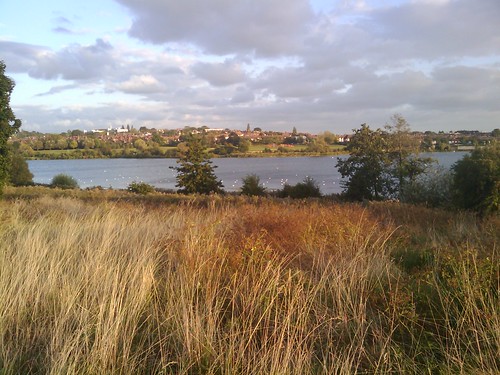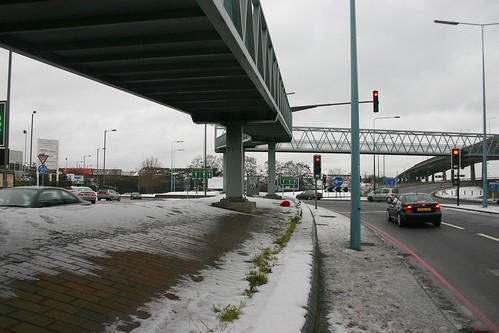
Within a short distance of where I live there is a large urban lake, The Brent Reservoir (or commonly known as the Welsh Harp, after the pub that used to stand next to it) that supports one of the most important bird habitats in southern England. Covering 110 acres, the reservoir is surrounded by mostly undeveloped land to the north and the bordered by playing fields, industrial buildings and the North Circular Road to the south. On the approach from Golder’s Green, it seems like an unlikely find (Google Maps link) after navigating the pedestrian-unfriendly territory surrounding the Brent Cross Shopping Centre and the walkways over the North Circular Road. The only hint of water is the garbage-strewn, concrete-lined River Brent that flows next to the car park at the mall.
If you travel slightly further to the southwest, you will cross the M1 motorway (the very beginning of it) and Edgeware Road. From there it is a short walk downhill to Cool Oak Lane, a one lane road controlled by a signal to let cars through one direction at a time. The open water of the Reservoir is to the left, usually dotted with sailboats and the right is marshier looking and there are often people feeding ducks and geese.

While the Reservoir today is a site of recreation and now appears to be a natural feature in the landscape of the area, it was created for utilitarian reasons. In the early 1800s, the canal network in London was rapidly being expanded to move cargo both around the city and north to Birmingham. More water was needed for both the Grand Union Canal and the Regent’s Canal, so the Regent’s Canal Company elected to dam the River Brent. Under a 1819 Act of Parliament, the reservoir was completed as a source of water for the Paddington Basin.
The area’s recreational appeal was obvious. William Parker Warner, owner of the nearby Welsh Harp Inn, turned the area into a fashionable socialising resort in the late 1800s (he was so influential, the Reservoir is often called the Welsh Harp today).  As a result of the area’s popularity, the Midland Railway built a Welsh Harp Station, which operated from 1870 through 1903. The body of water also became an attraction for Victorian naturalists, and was featured in the 1866 book The Birds of Middlesex. Today, it is recognised as a Site of Special Scientific Interest.
Landscape Urbanism has, to a large extent, been focused on post-industrial remediation.  At its core it represents the blending of engineering and landscape design in a synthesis that satisfies a variety of disparate criteria. In describing the work of West 8, Charles Waldheim describes their work as “imaginatively reordered relationships between ecology and infrastructure,”* which I think could similarly be used to describe the Brent Reservoir. On one hand, it made possible a key industrial transportation network, and on the other it created a spectacular habitat for wildlife and a recreational outlet for the rapidly growing city of London.
What is unfortunate about the site is that latter infrastructural investment in was focused on monofunctional improvements, mostly to the road network. The North Circular Road was built close to the south edge of the lake in the 1920s and the M1 was later built to the East. Both function as barriers to residents in the surrounding neighbourhoods and make it difficult to visit the lake and surrounding parkland. While there are walkways in the vicinity of these roads, they are clearly an afterthought- they are often hard to find and unsafe to use.  The image below is taken not far from where the Welsh Harp Station once stood.

What this part of London desperately needs is what Bruce Mau describes as a “radically different idea of the city- one that presents a synthesis of both man-made and the natural.”** We need more of the spirit of the Welsh Harp injected into the Brent Cross Shopping Centre, the M1 Motorway and the North Circular Road.
*Waldheim, Charles. “Landscape as Urbanism” in The Landscape Urbanism Reader (Charles Waldheim, editor), Princeton Architectural Press 2006, p. 45
**Mau, Bruce. “Design and the Welfare of All Life” in Design Ecologies (Lisa Tilder & Beth Blostein, editors), Princeton Architectural Press 2009, p. 24.